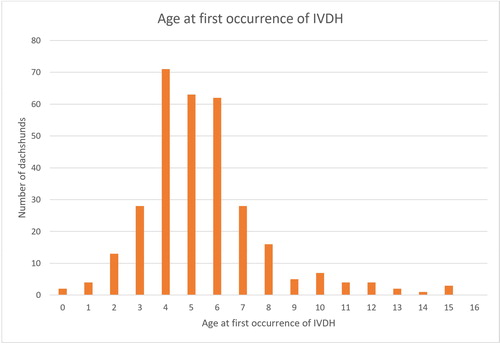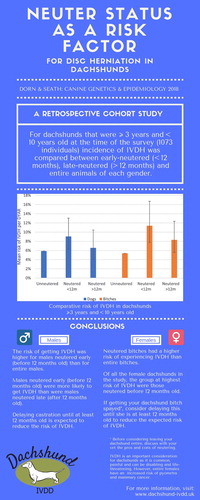
DACHSHUNDS ARE ONE OF THE UK’S MOST POPULAR PEDIGREE DOG BREEDS and, although many people might think they are lap dogs that don’t take much exercise due to their short legs, they actually originate from a very active working breed. Their short legs are a result of a genetic mutation that is thought to have occurred around 4000 years ago, but this mutation also results in premature ageing of the disc material in their spines, making them more prone to back disease than other breeds. As a breed, they are around 10 times more likely to suffer a back problem than the average breed of dog and about 1 in 4 dachshunds will suffer some degree of back problems during their life. Back disease is more correctly described as Intervertebral Disc Disease (IVDD) or Herniation (IVDH).
Given this background, the Dachshund Breed Council (DBC), a Kennel Club body that represents the UK’s breed clubs, has been proactive in assessing the health of the breed and conducting research to help improve health. I am Chairman of the DBC and have been able to apply my O.R. skills to our work on breed health improvement. In 2015, with the help of researchers at the Royal Veterinary College (RVC), we designed and analysed a breed survey to identify lifestyle factors that were associated with the risk of back disease.
NOVEL FINDINGS
The design of the study included factors such as body proportions (length:height, weight), diet, exercise and neuter status. The survey ran for three months and gathered just over 2000 responses. Initial analysis looked at individual variables to calculate Odds Ratios (e.g. the ratio of longer-bodied dogs with IVDD to those without IVDD).
While most people would assume that longer dogs would be more prone to IVDD, the evidence did not support that theory. Dietary factors also were not associated with IVDD risk. Several surprising findings emerged:
Dachshunds that had been neutered had an increased risk of IVDD and those neutered under 12 months were at a higher risk;
Those that lived with more than one other dachshund had a lower risk.
Additionally, and unsurprisingly, those that had more exercise and were more physically active had a lower risk.
I carried out this initial analysis and then the dataset was further analysed by the team at the RVC. They were able to carry out more sophisticated multivariate analyses to look at the interactions between several factors and IVDD prevalence. The whole study was published in the peer-reviewed Journal of Canine Genetics and Epidemiology in 2016.
Neutering can have adverse effects and it is increasingly apparent that the evidence for benefits and disbenefits needs to be considered on a breed-by-breed basis

FROM ANALYSIS TO IMPACT
The Breed Council had been active in promoting the importance of dachshunds having an active lifestyle to keep them fit and healthy, but the 2015 study provided further evidence that could be used to help reduce the risk of IVDD.
Around half of all dogs in the UK are neutered and many vets recommend this is carried out between 6 and 12 months. Neutering is carried out for a range of reasons, including population control and to prevent conditions such as mammary tumours in bitches. Recent studies have shown that neutering can also have adverse effects and it is increasingly apparent that the evidence for benefits and disbenefits needs to be considered on a breed-by-breed basis, not at a species level. The findings therefore had the potential to make a significant impact on the breed’s health if they could be translated into different decisions being made by owners and vets.
So began a two-pronged communications strategy targeted at owners and vets. At the end of 2016, the DBC launched a website (www.dachshund-ivdd.uk) and a Facebook Group focussed on providing IVDD advice and guidance to owners. They also began work to raise awareness of the association between neutering and IVDD among veterinary surgeons.
COLLABORATION AND MORE ANALYSIS!
Veterinary surgeon Dr Marianne Dorn joined the DBC team and, aided by her husband (an actuary), went to work on a more detailed analysis of the neutering data to provide an up-to-date review of the evidence on IVDD in Dachshunds, linked to the risks associated with neutering.
This study set out to investigate the possible relationship between neuter status and risk of IVDH in dachshunds. The aims of the study were twofold: to investigate
whether neuter status is associated with increased risk of IVDH in either male or female dachshunds,
whether neutering before 12 months old, as opposed to after 12 months old, is associated with increased risk of IVDH in dachshunds.
Our hypothesis was that neutered dachshunds, and especially those neutered before 12 months old, would have a higher incidence of IVDH.
The first task was to clean the data into a set of cases and controls. Of the original 2031 survey responses, 1964 ended up in the sample for analysis. The cases set were dogs that had been diagnosed as having IVDH by a veterinary surgeon. We used Power Analysis to determine the sample sizes required to be able to detect an effect and to avoid false positives and false negatives. It was calculated that at least 100 animals were required per group, so this number was easily achieved from the cases and controls. For dachshunds that were ≥ 3 years and < 10 years old at the time of the survey (1073 individuals) incidence of IVDH was compared between early-neutered (<12 months), late-neutered (>12 months) and entire animals of each gender. shows the histogram of age of IVDH diagnosis for 313 dachshunds in the survey. Most dogs are first affected between the ages of 4 and 6.
The original analysis (2015) had reported prevalence data and Odds Ratios. For this follow-up, Incidence rates were estimated to evaluate the rate of IVDH onset using dog-years at risk (DYAR). The number of cases of IVDH was divided by DYAR for the age range 36–120 months to calculate mean incidence per DYAR.
RESULTS AND CLINICAL SIGNIFICANCE
Neutered females had nearly twice the risk of IVDH than entire females. For neutered males, incidence of IVDH was also slightly increased but this was not statistically significant.
For both genders, there was a significantly increased risk of IVDH in dachshunds neutered before 12 months old as compared with those neutered after 12 months. For females, the risk was 2.1 times and for males it was 1.5 times.
The study concluded: ‘Results from this retrospective study suggest that gonadectomy, especially if performed before 12 months old, increases risk of IVDH in this breed. Decisions regarding neutering should be made on an individual basis, taking a range of pros and cons into account. Considering the high prevalence, morbidity and mortality of IVDH in dachshunds, increased IVDH risk associated with neutering is a key factor to consider in deciding whether and when to neuter’.
COMMUNICATIONS CAMPAIGN
The paper was published in the Open Access Canine Genetics and Epidemiology Journal in November 2018. It was the most highly accessed paper in that journal (nearly 18000) in the first quarter of 2019. In addition to this paper, Marianne Dorn wrote an article on IVDD for first opinion vets which was published in the In Practice magazine.
Veterinary surgeons are one target audience for the information in this study and the other key group is dachshund owners. The DBC has publicised the study widely via social media and created an infographic () to communicate the findings visually. The aim is to provide the most up-to-date information on IVDD and influence owners’ decisions about neutering, with a view to reducing prevalence of the condition. A further breed survey was conducted in 2018 and replicated the 2015 findings showing the association between neutering and IVDD. A quick calculation showed that the overall breed prevalence of IVDD would have been reduced from 25% to 17% if the neutered dogs had been left entire. The DBC will conduct its next breed survey in 2021 and expects that the impact of their research and communication will translate into a reduction in IVDD prevalence.
The overall breed prevalence of IVDD would have been reduced from 25% to 17% if the neutered dogs had been left entire
Ian Seath, is a member of the OR Society and Chairman of the Dachshund Breed Council, a not-for profit organisation working for the benefit of Dachshunds and their owners. He is an independent consultant with more than 25 years’ experience of working with private, public and third sector clients. His work includes strategy development, process improvement and project management. He and his wife have owned dachshunds since 1980 and, this year, one of their dogs was a class winner at the world-famous Crufts dog show.
FOR FURTHER READING
- Packer, R.M.A. , I.J. Seath , D.G. O’Neill , S. De Decker and H.A. Volk (2016). DachsLife 2015: An investigation of lifestyle associations with the risk of intervertebral disc disease in Dachshunds. Canine Genetics and Epidemiology 3: 8.
- Dorn, M. and I.J. Seath (2018). Neuter status as a risk factor for canine intervertebral disc herniation (IVDH) in dachshunds: A retrospective cohort study. Canine Genetics and Epidemiology 5: 11.


